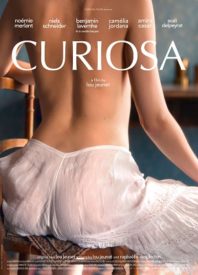
Pierre Louys (Niels Schneider) is a popular subject within the turn of the 20th century artsy Parisian circles. That’s especially true during his return to that gilded city. Those talking about him include Henri de Regnier (Benjamin Lavernhe) and his wife Marie (Noemie Merlant). See, Marie loved Pierre as a young woman but her father (Scali Delpeyrat) married her off to Henri.
I will write a lot of bad things about Lou Jeunet’s Curiosa, which depicts Pierre and Marie’s love affair. But to be fair to Curiosa, it at least expresses its milieu, with its interest in building its world. There’s a lot of close-ups of the objects that Pierre uses as a photographer. These photographs inspire Marie as a writer, supposedly.
This came out during the same year as Portrait of a Lady on Fire. Merlant’s character in Portrait is jarringly different from Marie, who is more oblivious and passive. Merlant features are unmistakable here but watching her move feels like she’s doing transformative work. She’s a different woman in love and in business, occasionally dealing with other family members (including Amira Casar)
Now comes the bad part. Curiosa mostly depicts Paris through boudoirs, studios, and staircases, inherently giving it a cagey feel. It doesn’t help that these three characters occupy these dusty spaces. That’s specifically true when Henri is around. It takes a lot of work in making a cuckold sympathetic and there’s no work here.
If anything, Curiosa takes a sadistic turn when Pierre tries to prove Marie’s infidelity towards Henri. He invites his friend to the apartment next door to make the latter hear them in flagrante delicto. Perhaps because of the movie’s methods, it feels like a pointless thing to depict on screen. I’ve always been apathetic towards heterosexual sex but this movie makes me dislike that now.
I wrote about Curiosa‘s objects d’art. Maire uses Pierre’s apartment and camera to have her own affairs and photographs. There’s something this b-plot that the movie doesn’t explain fully. And this is also the movie’s version of Marie gaining some semblance of agency and independence while also shaming her.
Some of the objects here also become subsumed within the movie’s surface fetishism. The staircases of Paris becomes the battleground between two women fighting over a man. Curiosa, by the way, depicts Pierre’s other lover (Camelia Jordana) in an offensively exotic manner. The real Pierre might have been worthy of two women, but this version of him isn’t.
Costume dramas are often about torrid affairs, but there’s nothing here that suggests anything that would fit that adjective. Merlant, as I previously wrote, is doing a lot of acting, expressing Marie’s ‘love’ and depression. But it’s as if the movie has no interest in exploring her interiority and motivations. Wasting Merlant in a film feels like a cinematic crime and it should be one.
- Release Date: 8/13/2021


